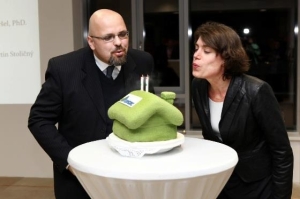I went to Eastern Slovakia last week. Those who follow my blog know that I keep returning there. It is not only because of the natural beauties of that region and the delightful people living there, but also because of a topic that my government has been following for years – the Roma community living there. Together with my political officer we set out for the road on snowy Wednesday only to find out that the East was without snowstorms and that sun was occasionally shining. And also to find some bright examples of Roma and majority co-existence… but also some gloomy ones.
Let me start with the very first meeting we had on our way in the municipality of Spišský Hrhov. There I met the local mayor, Mr. Vladimír Ledecký, who is currently serving his fourth term and who has successfully managed to integrate the local Roma community and significantly increase the population of the village. Nowadays, 1500 people live there, one fifth is of Roma origin. And there is harmony. The secret is hidden in the good management and good ideas of the mayor and his colleagues. The best example to mention is the local council’s (business) company which is employing mostly local Roma and the village has thus a low unemployment rate. People live in peace, Slovaks and Roma, without racial or other tensions. The number of inhabitants is increasing and new houses are built every year. The village was also mentioned as an example of a successful integration of Roma and a good co-existence of them with the majority in the World Bank report of 2012. Spišský Hrhov can definitely serve as a positive example for the whole country.
The next day I experienced a gloomy example – the Roma settlement in Moldava nad Bodvou. No asphalt road leading to the settlement and mud everywhere. The snow was melting and there were huge pools of dirty water and mud all around. Really poor conditions, also when you looked at the shacks and the devastated block of flats. But what struck me was the cleanness in the houses we randomly visited. I know that someone might object they cleaned them up prior to our arrival, but it was not like that – the people from ETP Slovensko who run a project there and who accopmpanied us, told us they always come there without telling. So the cleanness and the clean clothes of the kids are a regular thing. However, it did not change the fact that people live in small houses in big numbers. The good thing is that kids go to school and that there is the community center run by ETP. The center is good for the children for the after school activities, so they are busy and not wandering outside bored and looking for trouble. But the lack of a simple paved road kept on bothering me.
On the same day I talked to the reporters of Roma newspaper Romano lil in Prešov. They introduced me their newspaper and also talked about school debates and short movie projects they do around Northern and Eastern Slovakia with an aim to introduce the Roma minority (its struggles and successes) to students from the majority population but also from the Roma community itself. The short movies are a good thing, they show regular Roma (no celebrities) who lead a decent life. That is a very important message to pass on and to show these stories to Roma and non-Roma.
The last place I visited was another bright example which is worth to mention. I went to the village of Nitra nad Ipľom in Southern Slovakia and met with the local mayor, Mr. Tivadár Berky, who is of Roma origin himself. Mayor Berky told me the story of Nitra with 350 people (300 are Roma). Six years ago this remote village (only one road leads there) was in a bad shape with a high rate of criminality and drug dealing. However, the mayor in co-operation with his co-workers and police managed to push the dealers out and consolidate the life in village to that extent that people nowadays work, children go to school and both Roma and non-Roma live in harmony. And the mayor is a very caring person, he invests all his energy to the benefit of his people – for example, he prepares breakfasts for the kids in the school himself! It is thus no surprise that many Roma from nearby villages expressed their will to move to Nitra, however, there are not enough houses for sale. The story of this village is another positive example of a peaceful co-existence and the capability of Roma to function as a prosperous community. I was leaving Nitra nad Ipľom with a feeling that everything is possible. There “only” has to be a will to change and improve things. (And a paved road!?)
I know the media mostly serve the bad examples and the negative stories. However, there are many bright ones as well. I wanted to share them with you to show that Roma can be as good and successful in life as the majority population. Hopefully they will be more heard and known one day.
Kind regards,
Daphne Bergsma


 Sixty years ago, the Netherlands woke up into a horrible morning. It was Sunday, February 1st 1953, and the provinces of Zeeland, South Holland and Noord-Brabant were under water. Almost two thousand Dutchmen lost their lives. It was the day of the Watersnoodramp, the big flood disaster which came during the previous night. Today we commemorate the 60th anniversary of this catastrophe, but at the same time we also mark the beginning of a modern era in the water management in the Netherlands. And it is an interesting coincidence that a so called “water mission” from the Netherlands is coming to Slovakia in the days to come.
Sixty years ago, the Netherlands woke up into a horrible morning. It was Sunday, February 1st 1953, and the provinces of Zeeland, South Holland and Noord-Brabant were under water. Almost two thousand Dutchmen lost their lives. It was the day of the Watersnoodramp, the big flood disaster which came during the previous night. Today we commemorate the 60th anniversary of this catastrophe, but at the same time we also mark the beginning of a modern era in the water management in the Netherlands. And it is an interesting coincidence that a so called “water mission” from the Netherlands is coming to Slovakia in the days to come.